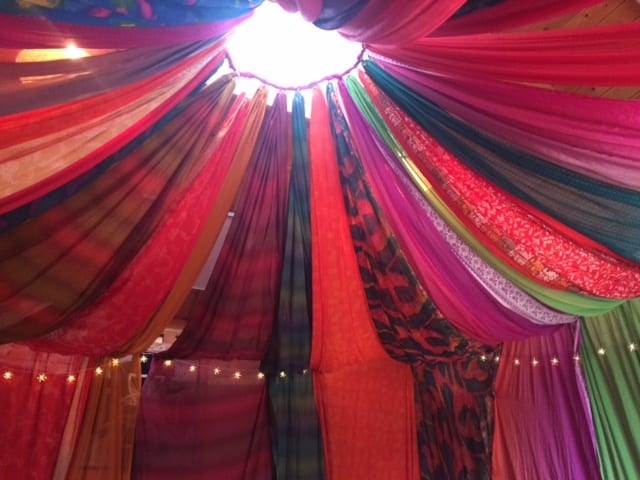Red Tents and Their Link to Spirituality
8 min read (1898 words)

Understanding the True Origins
Red tents, moon lodges and bleeding lodges have been misinterpreted by contemporary society. While some view them as structures that perpetuated menstrual stigma, their true history reveals spaces of profound spiritual and social significance. Far from being places of isolation or punishment, these sacred spaces served as centres of feminine wisdom, healing and community.
The tradition originates from Native American cultures, where women held pivotal roles in their communities. Before the advent of agriculture, whilst men focused on hunting and external relations, women managed the internal operations of their communities. They owned family housing, developed agricultural practices, preserved food, constructed dwellings and raised children. Most significantly, in many Native communities, women were entrusted with shaping the political, social, economic and spiritual direction of their people.
A Sacred Rite of Passage
Moon lodges and bleeding lodges functioned as sanctuaries where women could deepen their spiritual, mental and physical connections. These spaces honoured menarche—a girl’s first menstruation—as a significant rite of passage into womanhood. Young women received guidance about fertility, their changing bodies and the development of intuitive abilities.
Elder women served as mentors, sharing wisdom about the cyclic nature of feminine energy. These spaces provided safe, nurturing environments where women learned to honour their bodies through rest and self-care. They gained understanding of their cyclical nature, empowering them with complete agency over their well-being.
The Collective Power of Women’s Wisdom
These sacred spaces cultivated profound connections through meditation, celebration and creative expression. Women shared their deepest concerns, celebrated together through song and dance, and supported one another through life’s challenges. The indigenous peoples recognised that when women gathered, their collective intuitive powers strengthened, offering valuable insights for their communities.
Elder women who had fully embraced their cyclical nature throughout their lives became respected wisdom-keepers. Upon reaching menopause, they stepped into their role as guides for younger generations, maintaining this vital tradition of feminine knowledge.
Spider says…
“When women started to bleed, they left their homes and families to go to the sacred introspective space of the Bleeding Lodge. The Lodge was honoured and respected by the entire community, for the dreams and visions of the bleeding women brought vital survival information such as planting and healing knowledge and guidance on community relations. When there were questions that needed to be answered, the women would go to the Lodge and ask the Ancestors. All questions were always answered through the Ancient Ancestors. The entire community benefitted through the powerful gifts of the women’s bleeding cycle.
Since our Ancient Grandmothers probably all bled together, many women shared the Womb Lodge at one time. Ceremonies to honour our womb cycles, celebrate the cycles of the Earth and Moon, and rites of passage were developed by these women from visions and dreams during their bleeding times in the Sacred Lodge. These traditions were passed down in the initiatory rites of the Blood Lodge from mother to daughter.”
The Modern Context
In recent decades, much of this ancestral wisdom has been lost. The privatisation of healthcare has distanced many women from understanding their bodies’ natural rhythms. Modern society’s emphasis on constant productivity conflicts with women’s inherent cyclical nature, often leading to health implications and disconnection from our natural wisdom.
The Red Tent Movement Today
The contemporary Red Tent Movement gained momentum following Anita Diamant’s 1997 novel, “The Red Tent”. This reimagining of biblical women’s stories sparked a global revival of women’s circles. Modern red tents serve as spaces for women to learn about their cyclical nature, share wisdom, and find respite from daily demands.
Anita’s story touched many women’s hearts which resulted in many gathering across the world to create their own red tents. This is how the Red Tent Movement was born – modern red tents are used as a communal place for women to gather. They are seen as a place to learn more about our cyclical nature and how to care for ourselves. These spaces create a supportive community of women to lean on and learn from and they create a much needed retreat space for women to rest and heal. Red tents allow for women wisdom to be shared and rites of passages to be celebrated.
Creating Your Own Red Tent
When establishing a red tent gathering, consider these essential elements:
Purpose and Vision
Define your intentions clearly. Whether creating a healing retreat or building community, a clear purpose will guide your planning.
Practical Considerations
- Choose an appropriate venue and timing
- Determine participant numbers and invitation process
- Plan decorations and ambiance
- Establish opening and closing ceremonies
- Balance structured activities with organic flow
Remember that red tents can be adapted to various settings, including virtual gatherings for global communities. The essence lies in creating connection and supporting women’s well-being.
Embracing Cyclical Wisdom
It’s time to challenge the narrative that menstruation equals pain or dysfunction. Through education, rest and self-care, women can transform their relationship with their cycles. Understanding and working with our natural rhythms allows us to access the inherent wisdom of our bodies.
The revival of red tent traditions offers modern women a pathway to reclaim their connection to this ancient wisdom, fostering communities of support and understanding in our contemporary world.